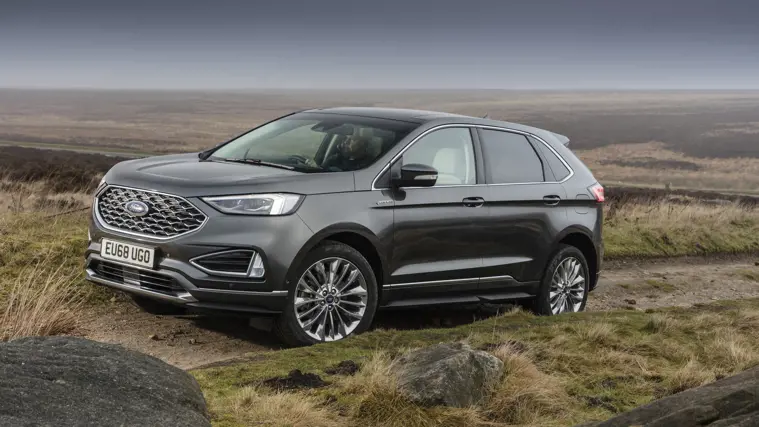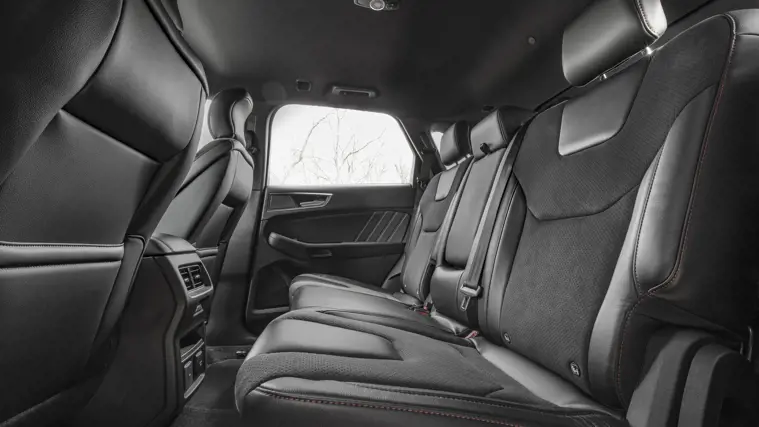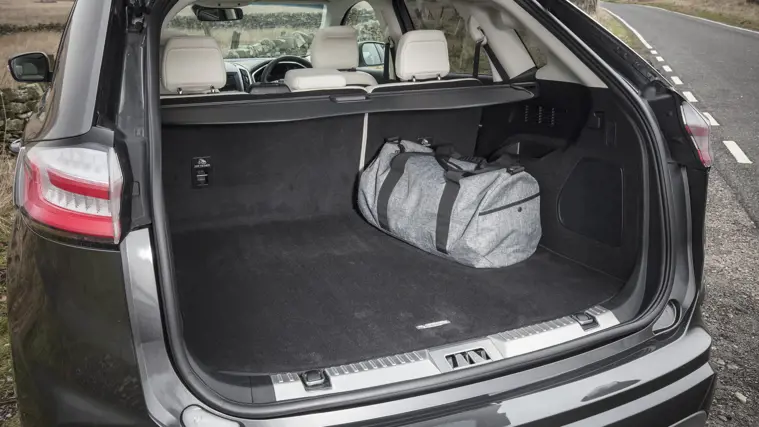Ford Edge (2016-2019) Review
The Ford Edge provides super-size family SUV motoring with surprisingly affordable finance
Strengths & weaknesses
- Large boot
- Quiet and comfortable
- All models are well-equipped
- Feels heavy and slow
- Bland interior
- No petrol engines available
With its big, bold grille leading the way, the Ford Edge has arrived from America to give British families a taste of super-size US motoring.
It reinforces a few stereotypes, not least because it’s big - particularly at the back. The 602-litre boot in the Ford Edge is more than 50 litres larger than those in the rival Audi Q5, BMW X3 and Mercedes GLC. The Edge is also longer, wider and heavier than each of them.
If you don't often need to negotiate narrow streets (it’s almost 2m wide), this sheer size makes the Edge a great family car. The boot will swallow buggies and bags, while there are lots of cubbyholes inside to store snacks and toys. There’s room for adults to sit comfortably in the back.
The interior is bland but sturdy and well equipped. Even the cheapest model at launch had a four-wheel drive system for better control in slippery conditions - though cheaper and more economical two-wheel drive versions have been launched since - plus a rear parking camera, and heated windscreen.
Choose the next model up and you’ll get a bootlid that can be opened by waving your foot underneath the bumper - useful when your hands are full - along with heated seats and sat-nav.
The Edge scored a five-star crash test rating when assessed in 2016 and has effective safety equipment as standard, including automatic emergency braking that helps you to avoid crashing into pedestrians or cars ahead, and a lane-keeping aid that steers the car back on track if you drift outside of the white lines.
Like many American cars, the Ford Edge is designed for long-distance drives. Noise cancellation technology helps keep the interior quiet and soft suspension on models with smaller alloy wheels and the standard suspension, smooths most rough road surfaces effectively. The ST-Line - with its standard sports suspension - and models with larger wheels, however, are less comfy.
The Edge is a good family SUV but isn’t for driving enthusiasts. You need to take corners gently or the car will lean noticeably, and you don't get much sense of how much grip the front tyres have left through the steering wheel, which makes it difficult to drive precisely on twisting narrow roads. Automatic models feel somewhat slow and sluggish, even with the more powerful engine and a manual gearbox is only available on used models now.
The problem for the Edge is that in cash term it's priced to compete with SUVs that offer more, such as the Kia Sorento which has seven seats, a more modern interior, and costs less. The basic Edge costs as much as well-equipped versions of the spacious Honda CR-V, or the efficient Mazda CX-5. However, bear in mind strong value PCP finance deals and very good value used deals and there are numerous affordable Edge models to choose from.
Meanwhile, in new car terms, a Land Rover Discovery Sport costs as much as one of the more expensive Ford Edge models but has a seven-seat option, a well-designed interior and better off-road ability. Or you could pick a Mercedes GLC, with its luxurious interior and comfortable ride. Alternatively, the BMW X3 and Jaguar F-Pace feel upmarket and are also more fun to drive.
Key facts
| Warranty | 3 years / 60,000 miles |
|---|---|
| Boot size | 602-litres |
| Width | 1928mm |
| Length | 4808mm |
| Height | 1692mm |
| Tax (min to max) | £145 to £185 |
Best Ford Edge for...
Best for Economy – Ford Edge 2.0 TDCI 210PS Titanium
Both Ford Edge engines have the same official mpg figure, but the more powerful version will probably be more efficient in day-to-day driving, as you won’t need to rev it as much.
Best for Families – Ford Edge 2.0 TDCI 210PS Titanium Powershift
A bootlid you can open by poking your foot under the bumper, sat-nav, and parking sensors at the front and back make this ideal for distracted and weighed-down parents.
Best for Performance – Ford Edge 2.0 TDCI 210PS Sport
Sport suspension and adaptive steering give the Edge a sportier feel, while 20in alloy wheels give a little more grip. Driving enthusiasts would be better off with a BMW X3.
One to Avoid – Ford Edge 2.0 TDCI 180PS Zetec
Until we’ve tested the lesser-powered Ford Edge, we are reluctant to recommend it, given how sluggish the more powerful car feels.
History
- May 2016 The first Ford Edge models arrive in Britain.
Understanding Ford Edge names
Trim level Zetec
There are three Ford Edge trim levels, which have different levels of standard equipment. The most basic version is the Zetec, followed by Titanium and then Sport.
Engine 2.0 TDCI 180PS
The description lets you know its size - 2.0 litres, followed by the fuel that it uses. Ford diesels are badged TDCI, which is the only engine type on the Edge. The power is given in horsepower, which can also be written as PS.
Driven wheels AWD
Currently, all Ford Edge models have All Wheel Drive, which means that power can be sent to all wheels for better control when slippery.
Gearbox Powershift
Powershift is the label that Ford uses for automatic gearboxes on Edge models. A 6-speed manual gearbox is also available.
Ford Edge Engines
2.0 TDCI 180PS, 2.0 TDCI 210PS
At the moment, a diesel-powered Ford Edge is your only option and you can choose between two power levels.
We’ve only driven the more powerful 210 horsepower (hp) engine, combined with an automatic gearbox. The engine was smooth and quiet - helped by noise-cancelling technology inside - but felt sluggish in getting the almost two-tonne Edge moving.
You’ll save £2,000 by opting for the less powerful 180hp engine, but this is slower to accelerate and has less pulling power, so is likely to feel underpowered.
Fuel economy is only average. Both engines have an official mpg figure of 48.7 (47.9mpg if you fit 20in wheels), which is likely to dip closer to 40mpg in real-world driving. The BMW X3 and Land Rover Discovery Sport are more economical.
CO2 emissions of 149g/km mean that road tax will be £145 per year. If you buy a car with 20in wheels, a slight increase in emissions pushes it into a higher category, costing £185 a year.
|
Fuel |
Mpg |
Power |
Acceleration |
Top speed |
|
|
2.0 TDCI 180PS |
Diesel |
48.7 |
180hp |
0-62mph: 9.9sec |
124mph |
|
2.0 TDCI 210PS |
Diesel |
48.7 |
210hp |
0-62mph: 9.4sec |
131mph |
Ford Edge Trims
Zetec Titanium, Sport
The Ford Edge range is due to expand, with more equipment options, but for now there are only three trim levels, with different levels of standard equipment.
The cheapest is Zetec, which comes well-equipped for an entry-level car. It has a rear parking camera, push-button start, 19in alloy wheels, electric folding mirrors, and dual-zone climate control that allows each front passenger to set the temperature for their side of the car.
There’s a big touchscreen at the centre of the dashboard with Ford’s Sync voice control, so you can call up a music track by talking to the car - as long as you speak clearly. There are other labour-saving gadgets too: a heated front windscreen; automatic headlights that switch on main beam if the road is clear; and windscreen wipers that activate if they sense rain.
There are also two effective safety systems: an automatic braking system called Active City Stop and Lane-Keeping Aid, which can steer the car back into its lane if it drifts out. Traffic sign recognition is also included, which can identify speed limits and display them to the driver, although the system is not completely accurate.
For a little over £2,000 more, the Ford Edge Titanium adds keyless entry; the doors unlock when you touch the door handles - as long as the key fob is in close range - and you can open the bootlid by poking your foot underneath the bumper. Front and rear parking sensors, sat-nav and heated front seats are also added over the Zetec trim.
Currently, the top-of-the-range car is the Ford Edge Sport, which is just over £2,000 more than the Titanium. This increases the size of the alloy wheels from 19in to 20in, which gives the car a firmer, and often bumpier, ride. The sat-nav is upgraded from a Ford to a Sony system. The car is also fitted with Sport suspension and adaptive steering, which is meant to give the car a sportier feel, but doesn’t go far enough.
If you’re buying a car fitted with the Sony sat-nav (optional on Titanium cars and standard on Sport), then you can also choose the Lux pack, which includes leather seats. They are electrically adjustable in the front, where they will heat or cool your posterior. Rear seats are also heated. A panoramic roof is also included, but this does reduce headroom in the back.
Other options available include a front wide view camera that gives you a view either side of the front of the car, which can help you see more clearly at junctions. A self-parking system is available, as are inflatable rear seatbelts can help avoid serious injuries in a crash.
Ford Edge Reliability and warranty
The Ford Edge is covered by Ford’s standard three-year warranty, which is limited to 60,000 miles: if you cover that distance before the end of three years, then the warranty expires. It’s a similar policy to those offered by many rivals, but far less generous than the seven years that you would get if you bought a Kia Sorento.
Used Ford Edge
Ford Edge finance deals sold by dealerships are being calculated on the basis that a three-year-old model will have lost 45% of its value after three years
This would mean that the Edge is one of the best cars in its category for keeping its value, which helps to reduce the cost of owning it (because you can sell it for more at the end). But it would make the car an expensive used purchase.







